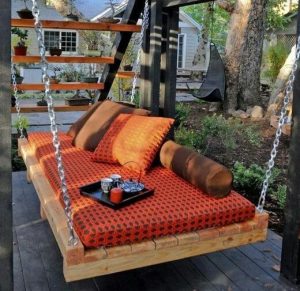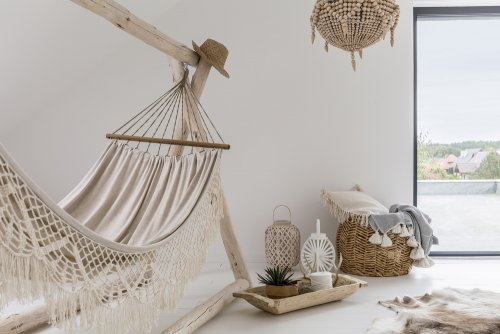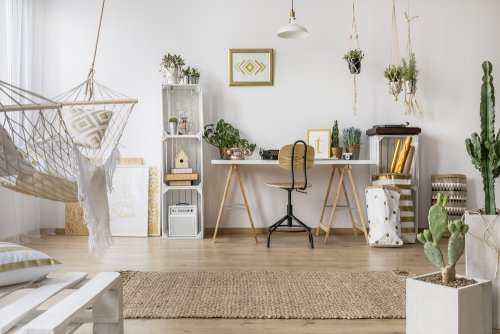Indoor Hammocks

Over the past few years, hammocks have become more popular, thus giving rise to the idea of an indoor hammock.
Indoor hammocks bring the entire concept of resting, relaxing and vacations into our homes. They’re perfect for creating that vacation feel all-year-long.
However, if you want to incorporate an indoor hammock in your home decor, you have to know what you’re doing.
In today’s post, we’ll fill you in all you need to know about indoor hammocks so you can set one up in your own home.
A little history
Hammocks originate from the native villages of Central America.
They were woven together with natural fibers and tree bark. The hammocks were then hung from trees to keep users safe from dangerous reptiles and rodents. In addition, many people hung their hammocks over the embers of the fire to keep warm during the night.
Hammocks inspired the Acapulco chair design

The origin of hammocks is another reason why we tend to associate them with paradise destinations like tropical jungles or beaches that seem a world away.
Indoor hammocks
There is a large variety of indoor hammocks. For our post, we’re organizing them by two criteria: shape and type of hang.
Looking at shapes, there are two main types of indoor hammocks.
- Traditional: this shape is elongated and can fit a person, laying down.
- Chair or swing: these kinds of hammocks take up less space than their traditional counterparts. They also come with different ways to hang them.

As for how a hammock can hang, there are two ways.
- Hung from each side: a hammock that hangs from both sides is perfect for homes with exposed beams. All you need to do is tie the hammock to the beams and you’re ready to go. On the other hand, if you live in a home without exposed beams, you should call a specialist to help you locate a good area to install your hammock.
You can also install your hammock directly onto a wall.
The hammocks that hang from both ends are the traditional types.
- Hung from the ceiling: these hammocks hang from a piece of rope or chain from the ceiling. You have to make sure that the ceiling is strong enough and won’t come crashing down on you. If you have a false ceiling, these hammocks aren’t suitable for your home.
Examples of ceiling hammocks include those that hang solely from one spot; they hang from the ceiling from their center. Hammocks that hang in this way can move in all directions and spin.
Additionally, there are also hammocks that hang from two different locations; hung from two different areas, they become a hammock-swing.
Another indoor hammock option
If you’re one of our readers that prefers to skip any kind of home project involving walls or ceilings, you still have an option. You can have an indoor hammock that stands on the floor.
These kinds of hammocks have several advantages. One is that they’re not fastened or anchored, so you can move them around.
Additionally, just because they have a stand doesn’t mean that they can’t swing. Standing hammocks are designed to replicate the original concept of hammocks, which is the swing.
Materials
Indoor hammocks won’t be exposed to changes in the weather and they don’t have to withstand high temperatures or rain either. That translates into a greater option for materials.
- Fabric: you could use cotton or linen. Both are strong materials that are breathable as well.
- Ropes at the ends of the hammock: these kinds of hammocks make us think of movies like Tarzan.
- Netting: simple and perfect for down-to-earth families.
- Needlework or crochet.

The materials that we’ve mentioned above are the more traditional hammock options. However, in our modern world, hammocks that are a little more elegant are becoming more popular.
Chair or swing hammocks often use more sophisticated materials. You can find indoor hammocks that use:
- Wicker
- Wood
- Basalt
- Iron or bronze
Hammocks that use materials other than fabric are definitely a more modern option.
Conclusion
Indoor hammocks are perfect for setting the mood in any part of your home. They’re great for placing right next to a bookcase, or in a snug corner in the living room.
Hammocks are fantastic in children’s rooms because they’re a fun change from the traditional sofa.
Additionally, indoor hammocks also hold a world of possibilities ranging from colors and patterns to different materials. You can find the right hammock for any kind of decor, whether it’s classical or minimalist, or even industrial or rustic.
Over the past few years, hammocks have become more popular, thus giving rise to the idea of an indoor hammock.
Indoor hammocks bring the entire concept of resting, relaxing and vacations into our homes. They’re perfect for creating that vacation feel all-year-long.
However, if you want to incorporate an indoor hammock in your home decor, you have to know what you’re doing.
In today’s post, we’ll fill you in all you need to know about indoor hammocks so you can set one up in your own home.
A little history
Hammocks originate from the native villages of Central America.
They were woven together with natural fibers and tree bark. The hammocks were then hung from trees to keep users safe from dangerous reptiles and rodents. In addition, many people hung their hammocks over the embers of the fire to keep warm during the night.
Hammocks inspired the Acapulco chair design

The origin of hammocks is another reason why we tend to associate them with paradise destinations like tropical jungles or beaches that seem a world away.
Indoor hammocks
There is a large variety of indoor hammocks. For our post, we’re organizing them by two criteria: shape and type of hang.
Looking at shapes, there are two main types of indoor hammocks.
- Traditional: this shape is elongated and can fit a person, laying down.
- Chair or swing: these kinds of hammocks take up less space than their traditional counterparts. They also come with different ways to hang them.

As for how a hammock can hang, there are two ways.
- Hung from each side: a hammock that hangs from both sides is perfect for homes with exposed beams. All you need to do is tie the hammock to the beams and you’re ready to go. On the other hand, if you live in a home without exposed beams, you should call a specialist to help you locate a good area to install your hammock.
You can also install your hammock directly onto a wall.
The hammocks that hang from both ends are the traditional types.
- Hung from the ceiling: these hammocks hang from a piece of rope or chain from the ceiling. You have to make sure that the ceiling is strong enough and won’t come crashing down on you. If you have a false ceiling, these hammocks aren’t suitable for your home.
Examples of ceiling hammocks include those that hang solely from one spot; they hang from the ceiling from their center. Hammocks that hang in this way can move in all directions and spin.
Additionally, there are also hammocks that hang from two different locations; hung from two different areas, they become a hammock-swing.
Another indoor hammock option
If you’re one of our readers that prefers to skip any kind of home project involving walls or ceilings, you still have an option. You can have an indoor hammock that stands on the floor.
These kinds of hammocks have several advantages. One is that they’re not fastened or anchored, so you can move them around.
Additionally, just because they have a stand doesn’t mean that they can’t swing. Standing hammocks are designed to replicate the original concept of hammocks, which is the swing.
Materials
Indoor hammocks won’t be exposed to changes in the weather and they don’t have to withstand high temperatures or rain either. That translates into a greater option for materials.
- Fabric: you could use cotton or linen. Both are strong materials that are breathable as well.
- Ropes at the ends of the hammock: these kinds of hammocks make us think of movies like Tarzan.
- Netting: simple and perfect for down-to-earth families.
- Needlework or crochet.

The materials that we’ve mentioned above are the more traditional hammock options. However, in our modern world, hammocks that are a little more elegant are becoming more popular.
Chair or swing hammocks often use more sophisticated materials. You can find indoor hammocks that use:
- Wicker
- Wood
- Basalt
- Iron or bronze
Hammocks that use materials other than fabric are definitely a more modern option.
Conclusion
Indoor hammocks are perfect for setting the mood in any part of your home. They’re great for placing right next to a bookcase, or in a snug corner in the living room.
Hammocks are fantastic in children’s rooms because they’re a fun change from the traditional sofa.
Additionally, indoor hammocks also hold a world of possibilities ranging from colors and patterns to different materials. You can find the right hammock for any kind of decor, whether it’s classical or minimalist, or even industrial or rustic.







